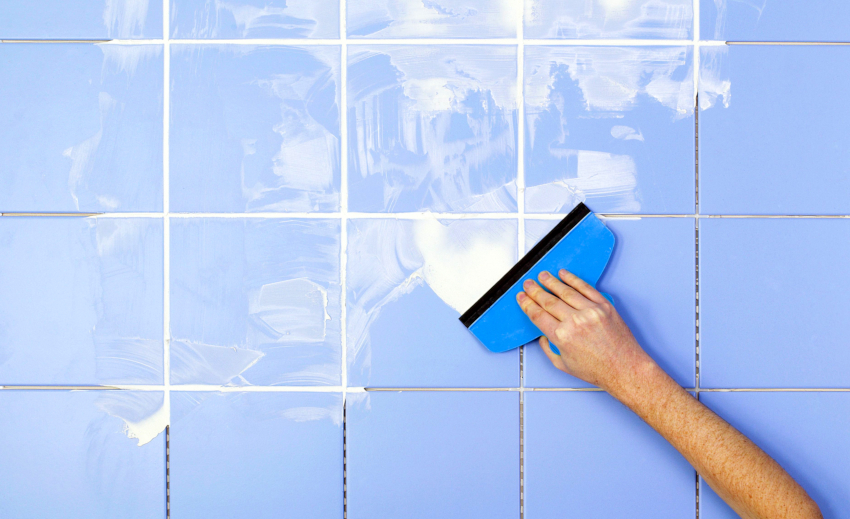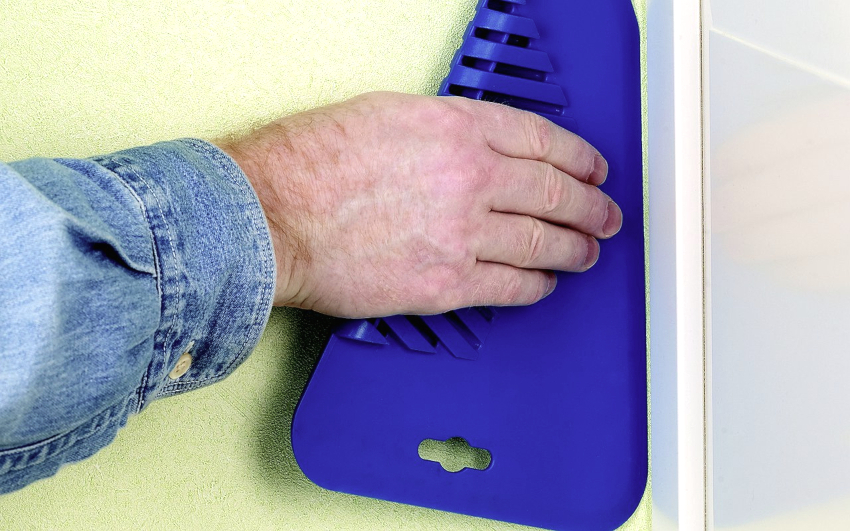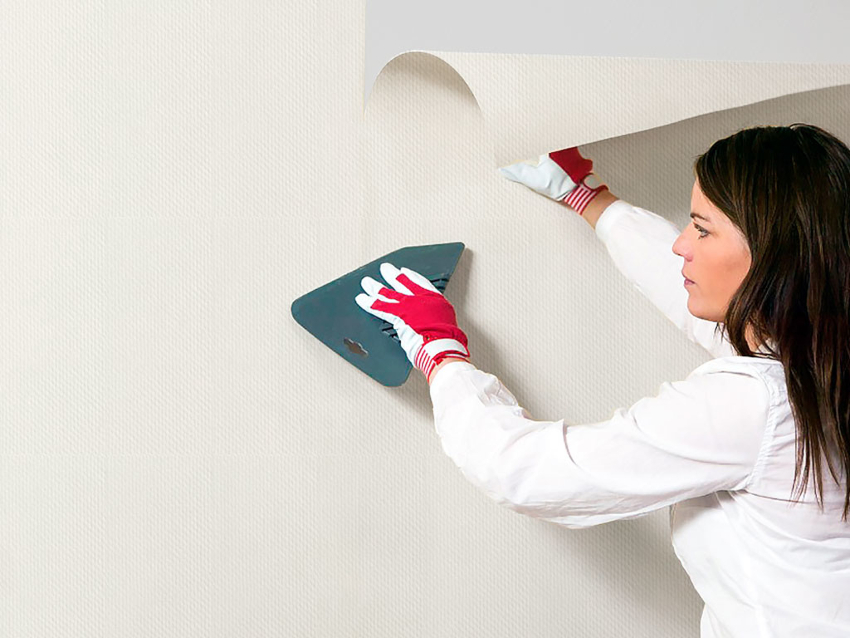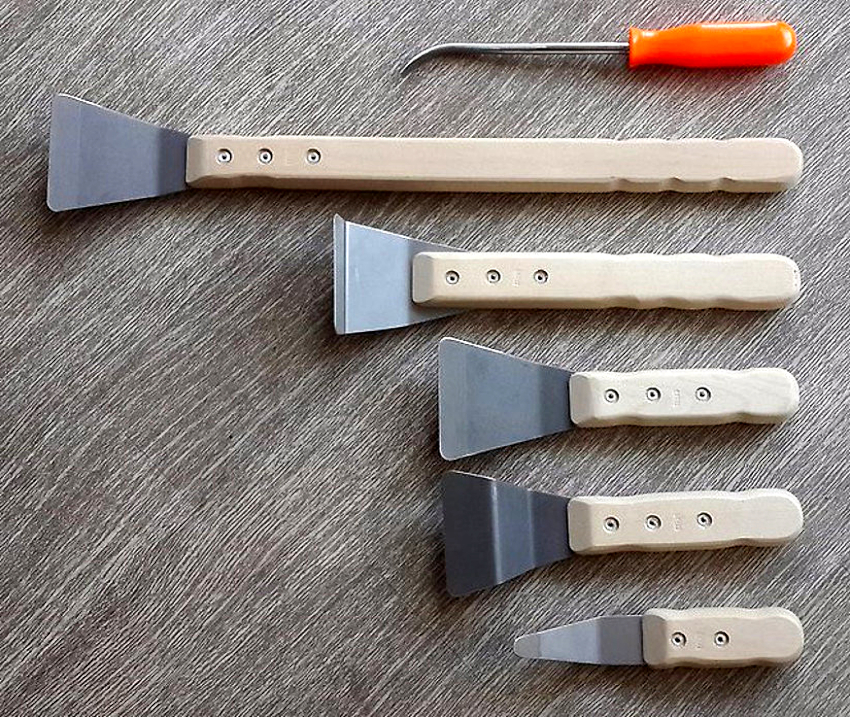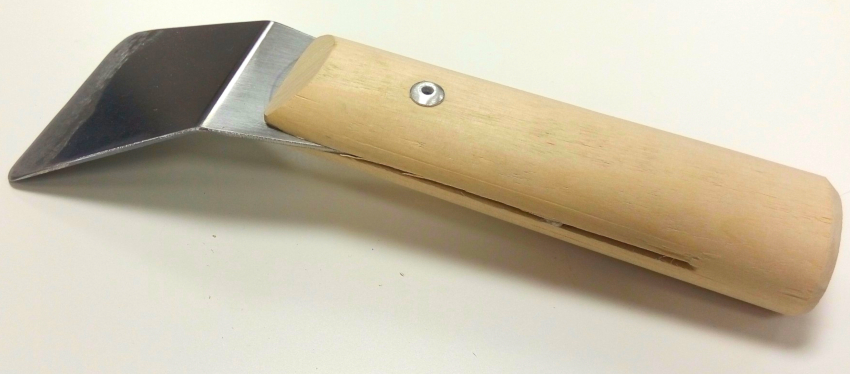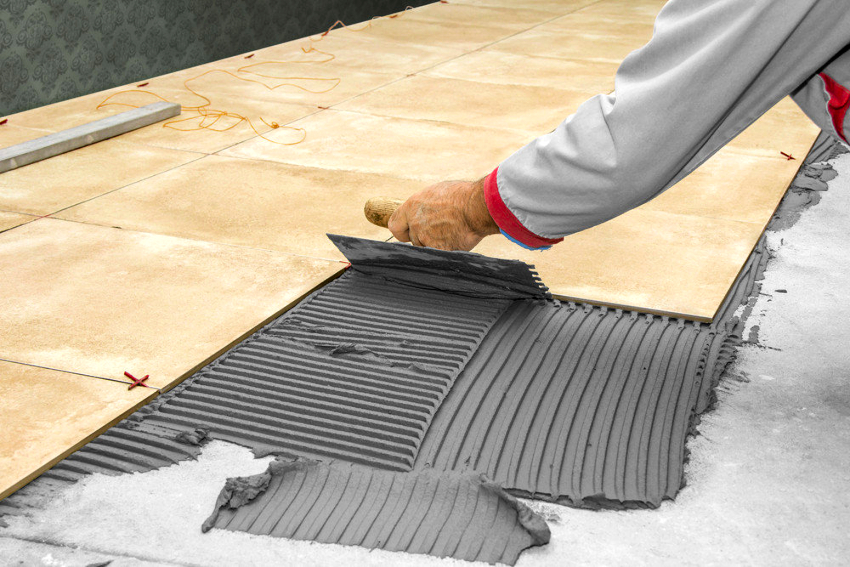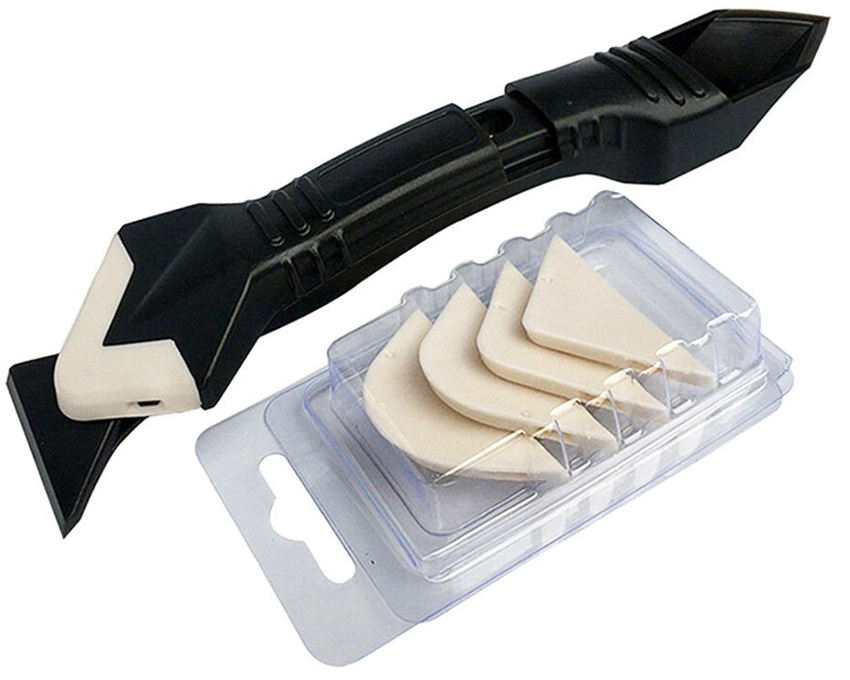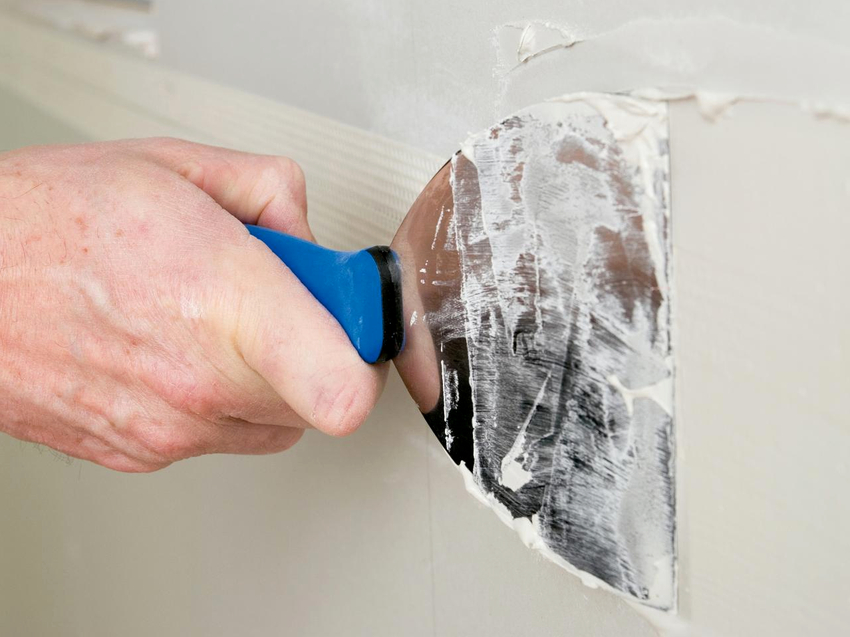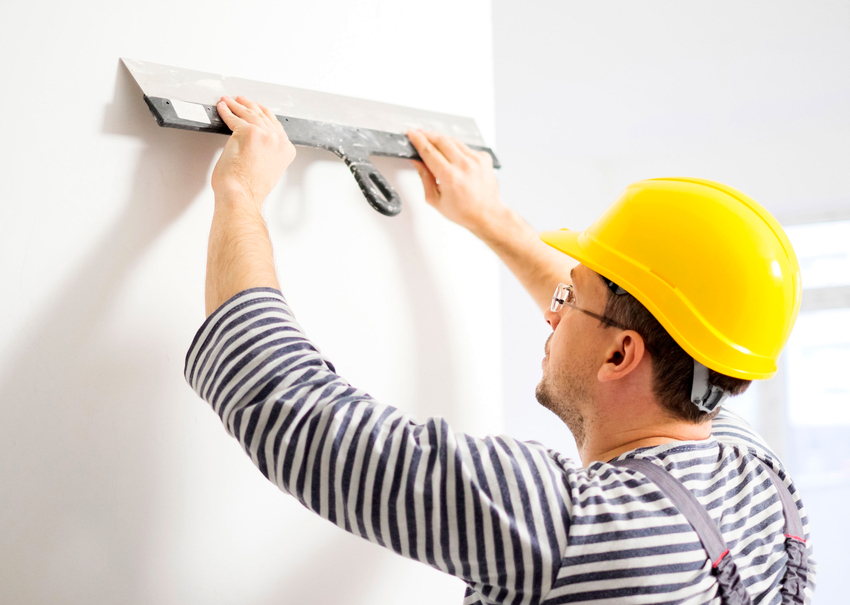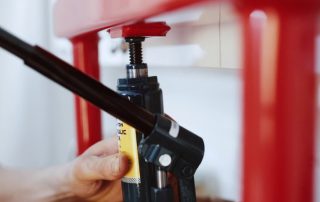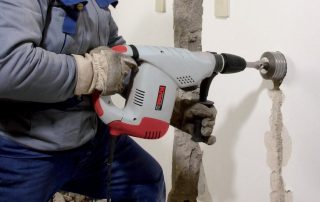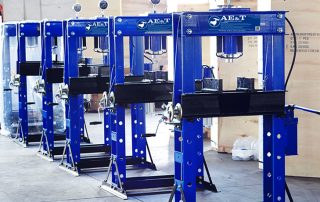In the process of finishing work both inside and outside the structures, it is often necessary to work with all kinds of building compounds. Especially for the convenience of the craftsmen, tools were created to simplify and speed up the application of finishing on the surface of buildings. Often, a putty spatula is used for this purpose. In order not to be mistaken in the choice, you should learn about the types and variations of these products.

To speed up and simplify the process of applying the putty to the surface, a tool such as a spatula was developed.
Content
- 1 Rubber trowel for grouting: tool features
- 2 Silicone spatula: a faithful assistant in the repair process
- 3 Wallpaper spatula: a guarantee of comfortable and efficient work
- 4 Spatula for stretch ceilings: distinctive characteristics of the product
- 5 Metal spatula: when efficiency comes from convenience
- 6 Tile spatula: the main secrets of popularity
- 7 Sealant spatula: variety of models
- 8 Putty spatula: a few words about proper use and care
Rubber trowel for grouting: tool features
Speaking of rubber spatulas, it should be noted that they differ from standard building products in the material of manufacture, as well as in the presence of an edge beveled at an angle of 90 degrees. These features ensure the seams are even and smooth.
Trowels can be used:
- as a tool for filling seam joints between tiles;
- in the process of working with parquet joints;
- to remove excess building mixture from the seams.
Important! Trowels for grouting are used exclusively for the specified work. If they are used for other tasks, they can be damaged and lose the ability to gently overwrite.
In particular, with their help, it is not recommended to carry out putty work. This is due to the fact that in this case the tool will become unusable much faster than any professional trowel for wall putty.
The use of this or that rubber device only indicates that either the work is coming to an end, or restoration begins after the manipulations have been carried out. Precisely because this process is the final touch, and in the future flaws are difficult to correct, you should be very careful when choosing a tool.
Silicone spatula: a faithful assistant in the repair process
Due to the rich assortment of the modern construction market, a variety of tools can be used to work with silicone material, but the appropriate spatulas are favorite for many craftsmen. This is due to their availability and ease of use.
When choosing a tool, special attention should be paid to such parameters as the size of the spatula, as well as its shape and types. Today the assortment is represented by the following types of products:
- a standard flat spatula, the width of the working surface of which ranges from 100 to 300 mm;
- a universal tool in the form of a spatula, which has a more rigid base for cleaning joints;
- corner product designed for sealing joints.
Often, to perform this type of manipulation, blades are used that have an angular curvature from the side of the working surface. In addition, while preparing for the repair, it will not hurt to purchase a set of tools for leveling the walls, which will greatly simplify the finishing procedure.
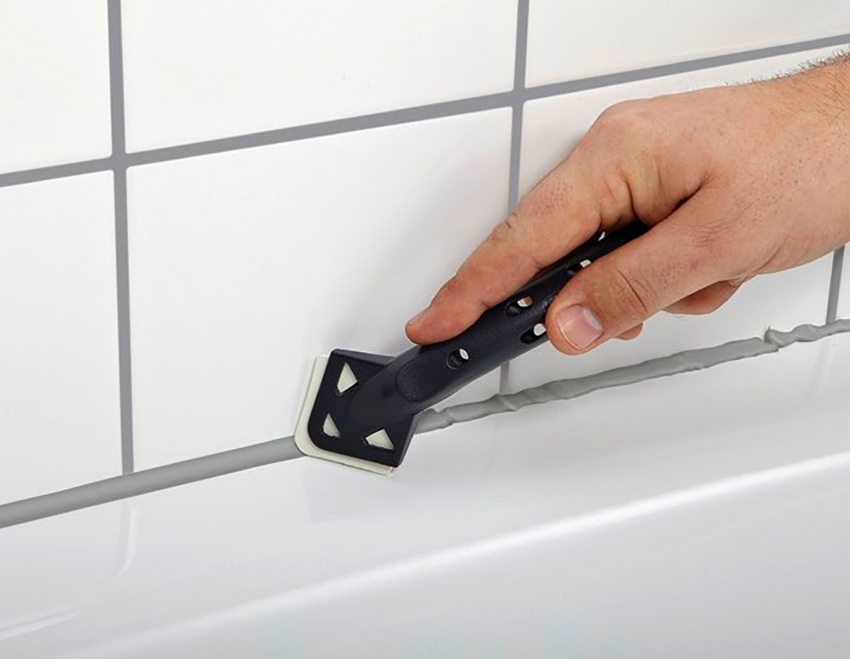
When choosing a spatula for silicone, you need to pay attention to parameters such as size and shape
Note! In the process of carrying out work, it is best to remove excess material after complete solidification. This will ensure the utmost tightness at the joints.
In addition, when rubbing in, it is recommended to re-pass the seams after applying the primary coat. This allows you to achieve maximum surface protection against moisture.
Wallpaper spatula: a guarantee of comfortable and efficient work
The presented device appeared much later than wallpaper. However, this tool has earned the respect of thousands of users who value practicality and convenience in particular.
Looking through photos of wallpaper spatulas, many ignore such a parameter as the shape of the product. And in vain. This characteristic is of key importance - the degree of convenience in the process of performing work depends on it.
To date, you can find on sale accessories of the following types, depending on the shape:
- classic;
- trapezoid;
- universal;
- hold-down.
Classic tools resemble the standard size putty knives. However, there is one significant difference: they are made entirely of plastic. The presented option is an excellent solution if you have to work with heavy surfaces, and the finishing area is quite significant.
It is interesting! The configuration of the classic versions provides the ability to expel excess air and glue extremely quickly, even when large rolls are used.
Trapezium spatulas are often small in size. This makes them very convenient to store. These tools are incredibly effective with little work. With their help, you can not only level flat surfaces, but also work in corners.
As for the universal glue spatulas, they acquired the original name - "shark fin". These products are used in the process of performing work much more often than any other types of spatulas. This is not surprising, because they are characterized by convenience, therefore they will be an excellent option for use by craftsmen with limited experience.
Presser spatulas are slightly less common than other configurations. However, some masters exclusively recognize them. This is due to the fact that the grip of this instrument is characterized by tremendous convenience, and its shape is presented in a semicircle. Due to these qualities, you can smooth out even the most difficult-to-reach areas with maximum efficiency.
In the selection process, convenience is the main criterion.At the same time, there is no single requirement as to how to properly hold the spatula when filling the walls. If the instrument fits comfortably in the hand, you can safely purchase it without fear that the choice will become wrong.
Spatula for stretch ceilings: distinctive characteristics of the product
The process of creating flawlessly even and durable stretch ceilings is a rather difficult task, the implementation of which would be simply impossible without a variety of additional tools. In addition to a grinder and a punch, which every owner will surely have, for work you will need products such as spatulas. They are needed in order to tuck the tension cover into the profile.
It is interesting! Perhaps the main difference between spatulas for stretch ceilings and classic products is the presence of special tips on them, which have a bend at a certain angle.
The presented tools are equipped with wooden or plastic handles of various lengths. Moreover, each model is designed to perform a specific type of work on a specific section of the ceiling.
The evenness and strength of the ceiling directly depends on the quality of the spatula, as well as on how correctly it is produced. By choosing the right tool, you can not only greatly simplify and speed up the installation process, but also preserve the integrity of the canvas.
Some of the parameters that deserve special attention when choosing a product include:
- the degree of handle length;
- bending angle of the metal tip;
- blade width;
- the material from which the handle is made.
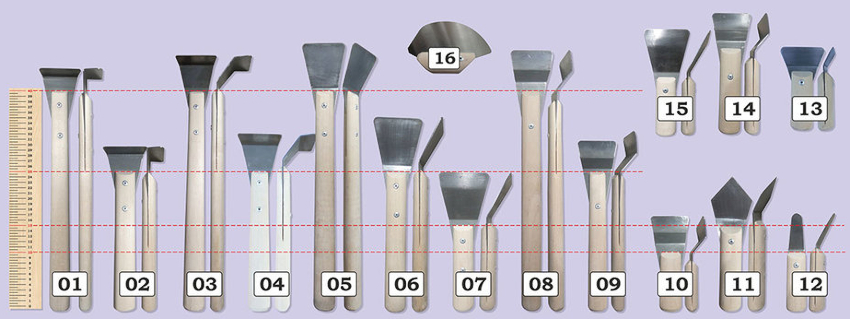
Cornice spatulas: 01 - 90 ° angle, 02 - 90 ° angle, 03 - 45 ° angle, 04 - 45 ° angle; standard spatulas: 05 - standard blade, 06 - standard blade, 07 - wide blade, 15 - wide blade; goose-type spatulas: 08 - standard blade, 09 - standard blade, 14 - wide blade, 10 - wide blade; trowels for non-standard ceilings: 11 - corner trowel, 12 - tongue, 13 - corner trowel, 16 - for fabric ceilings
Depending on the type of work carried out and their scale, tools of various configurations and sizes can be used. During the installation of rather complex structures, up to 6 types of them can be used.
The most common sizes of spatulas for working with tension blades are:
- Large 45 °. They have a long handle up to 40 cm and a curved blade with a straight blade. They are a basic tool for threading the web into any type of profile.
- Compact 45 °. They differ from large ones in the level of the handle length, which often does not exceed 12 cm. They are indispensable in the process of working in hard-to-reach areas.
- Large 90 °. Endowed with a straight long handle (up to 50 cm) and a trapezoidal blade. They are used to perform works related to drywall boxes, as well as stepped profiles with hidden lighting.
- Large triangular 45 °. On their elongated handles are fixed narrow blades of a triangular shape. Such products are used to fix the canvas in uncomfortable, narrowed places.
- Feathers are even. Possessing a long and flexible spatula with a comfortable handle, such spatulas are useful when fixing the film in the places where different types of pipes are intertwined.
- Corner 45 °. Their peculiarity is that the working part has the shape of a right-angled triangle. This ensures a clear grip and fixation of the film at the corners of the frame.
Today, hardware stores have a large assortment of tools designed to work with stretch ceilings.Manufacturers present to the attention of consumers a variety of models of spatulas for wall putty, the sizes and configurations of which are striking in their variety. Thanks to this, each master will be able to choose exactly the product that will most effectively cope with the tasks.
Metal spatula: when efficiency comes from convenience
The presented products are used for laying a layer of plaster, with which the surface is leveled. Often, such tools are used to smooth out pre-treated walls or ceilings, as well as in the process of applying decorative solutions or putty. It is with the help of a spatula for plastering walls that you can effectively get rid of cracks and irregularities on the surface.
Especially for the convenience of work, many varieties of these tools were made. The most common are:
- Angled trowel used to create proper angles. When using it, errors in degrees are completely eliminated.
- Serrated products, widely used in the process of applying tile adhesive for the best bonding. Depending on the variety, their teeth are designed for different weights of solutions and tile dimensions.
- Curly tools that brilliantly cope with the task of the original design of ceilings. Irregularities on the work surface create unusual patterns. At the same time, in order to form unique elements, everything should be done chaotically.
Important! When buying a metal tool, you need to pay special attention to its width. An overly massive product will only interfere, which will negatively affect the quality of the finished work.
As for the optimal size of spatulas for wall putty, the best option is 300-500 mm. However, the amount of work to be carried out should also be taken into account.
Related article:
Video: do-it-yourself wall putty for wallpaper
How is it correct, putty or putty? Types of mixtures, nuances and features of puttying on different surfaces
For example, narrow models are suitable for rough putty, and the most compact ones are used for finishing crevices, corners and cracks. Large tools come in handy when deep cuttings are needed. In just one run, they will cope with the task of leveling the walls.
Tile spatula: the main secrets of popularity
The simplest tool for tiling a wall or floor is a trapezoidal plate with a handle. At the same time, it can either be attached directly to the working plane, or be located perpendicular to it.

The tile spatula is a plate with a handle that can be attached both to the working plane and perpendicular to it
In addition to the above parameters, the ridges differ from each other in the following characteristics:
- The size. The width of their working surface can be from 10 to 45 cm.
- Teeth type. This indicator determines which adhesive mixture can be used when performing work. Semicircular elements are suitable for cement or synthetic compounds, and triangular ones will cope with mobile solutions that are applied in a thin layer.
- Material. If you have to grout the joints, you can safely choose rubber or rubber, but if you intend to apply an adhesive composition, you need to purchase metal products. At the same time, it is not recommended to use plastic, since it does not differ in durability.
The styling tool will last much longer if you take into account all the little things when buying:
- Just as in the case of a plaster spatula, before purchasing it is necessary to take the product and try to perform several movements with it.The handle should fit comfortably in the palm of your hand and should not slip.
- If the instrument is large, a plastic handle should be preferred to prevent hand fatigue.
- If the handle is made of wood, it is better to choose a lacquered version to prevent splinters from getting under the skin.
- If you plan to lay tiles on the floor, a trowel with large teeth would be the best option.
Note! High cost does not always guarantee the appropriate quality. In the selection process, instruments should be compared on the basis of specifications, not prices.
Good products shouldn't be too rigid or flexible. In the first case, they can simply break, and in the second, the pressure of the proper force will not be provided. In order not to purchase a dozen products, it is more convenient to acquire one or more, the difference in which is in the shape of the edges.
Regardless of what product is needed, be it a professional spatula or a tool for performing repair work at home, in the selection process, you should focus primarily on the degree of ease of use and the level of quality of the material.
Sealant spatula: variety of models
Without sealing and professional sealing of joints and seams, it is hardly possible to carry out high-quality installation of finishing materials and structures during the execution of both external and internal construction work. Of course, this will require a number of special tools, the place of honor among which belongs to the spatula. It is with its help that you can gently remove excess sealant, giving an aesthetic appearance to the structure.
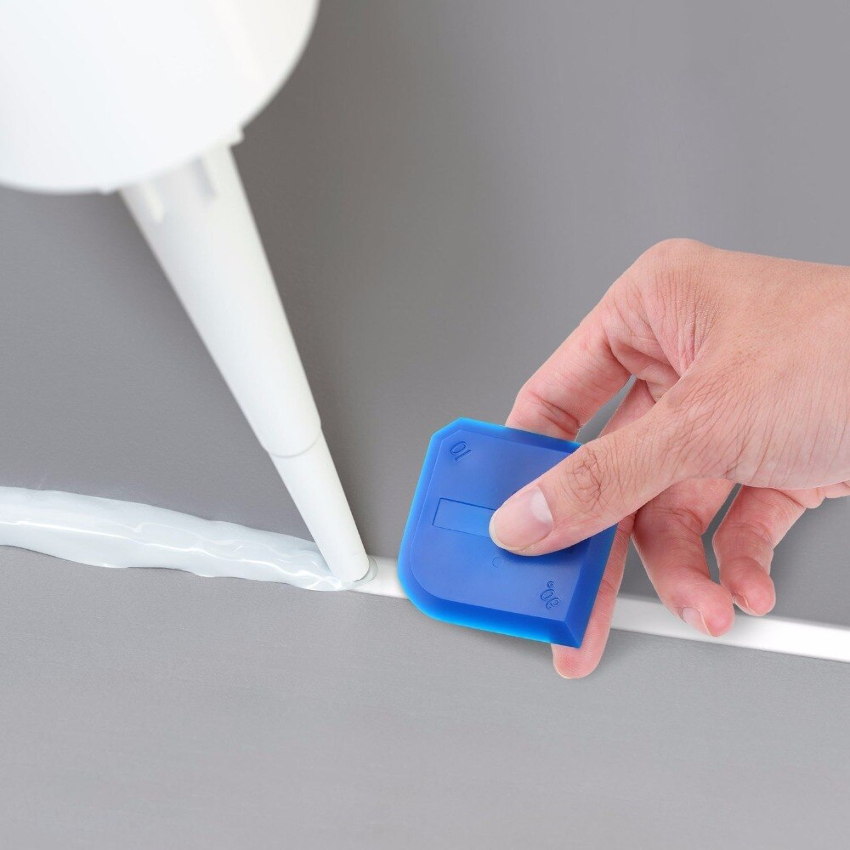
It is with the spatula for the sealant that the excess material can be gently removed, giving an aesthetic appearance to the surface.
The peculiarities of using spatulas for sealant are a special aspect that should not be forgotten during the construction work. Today, there are many models, each of which is intended for the implementation of different tasks. For example, it is important to understand that a sterile wooden spatula will not work at all if you need to process the joints in the bathroom.
Helpful advice! Although some advise moistening the spatulas with soapy water to reduce the adhesion between the silicone and the tool, the best effect is obtained by dipping the product in diluted dishwashing detergent.
As for the material of manufacture, it is worth noting that these tools can be made from rubber, plastic or rubber. If the master is looking for a product for household use, rather than a professional putty putty knife, a silicone tool is recommended, since it is characterized by practicality and convenience. Moreover, it is much more difficult to break than alternative models.
Taking into account the above nuances, you can choose a truly high-quality product that is best suited for the implementation of construction ideas.
It is interesting! In addition to construction, these products are also widely used in the field of medicine. A disposable wooden spatula is a necessary attribute of an ENT doctor.
In addition to the above options, today also spatulas for auto putty are very popular. These accessories are especially valuable consumables for painting and repairing car bodies. Narrow, medium, large - today various products are presented to the attention of motorists, which are designed to significantly improve the process of restoring the coating of the "iron horse".
There is such a thing as mechanized putty. This type of work is performed using special equipment.A spatula for mechanized putty will not be enough, and therefore in this case it is recommended to use a putty station. The main feature of the mechanized process is that the apparatus is able to prepare a solution and simultaneously direct it to the surface under pressure.
Putty spatula: a few words about proper use and care
The trowel for grouting will become a faithful assistant in the process of finishing work. In addition, it can be used to fill joints with a cement or epoxy mixture.
The basic algorithm is reduced to applying the compound to the joints, as well as to further removing its excess from the surface. In the presented case, the type of material, be it epoxy or cement mortar, does not matter at all. However, in the process of work, it is necessary to pay special attention to the differences in terms of texture and efficiency of filling the seams.
If we are not talking about a disposable spatula, just like any other instrument, these products need care. They must be constantly cleaned, removing the mixture, and also make sure that no microcracks appear on the surface. In addition, it will be necessary to trim the damaged areas at the edges of the rubber elements from time to time.
After the material has been applied, the spatula must be washed in a solvent. If the product leaves behind any irregularities, its working surface should be sanded with fine sandpaper. To do this, you have to perform the following actions:
- place fine-grained sandpaper on a flat surface;
- install the spatula in an upright position;
- drive along the paper with the working edge of the tool;
- run your fingers along the working edge to make sure there are no burrs.
Important! A spatula purchased even at a high price will quickly become unusable without proper care.
In the case of correct use and careful maintenance, the service life of the product will be quite enough for a rather long period, and the master will be given the opportunity to grout more than a dozen joints with his help.
Many types of construction work are not complete without a spatula. It is an essential tool for patching up gaps, laying tiles, removing previous whitewash or wallpaper, and for decorating walls. The degree of quality of the selected product depends on how favorable the decor will look. Classic Venetian plaster, imitation of a silk surface, finishing "Bark beetle" - decorative spatulas will brilliantly cope with these tasks.
To date, a huge range of putty spatulas is presented in hardware stores, the price of which varies depending on the size and characteristics of the products. They are intended for leveling walls, gluing wallpaper, working with stretch ceilings, leveling corners, applying mixtures - the scope of these accessories is really wide. The presented tool will become simply an irreplaceable assistant in the process of finishing work.

